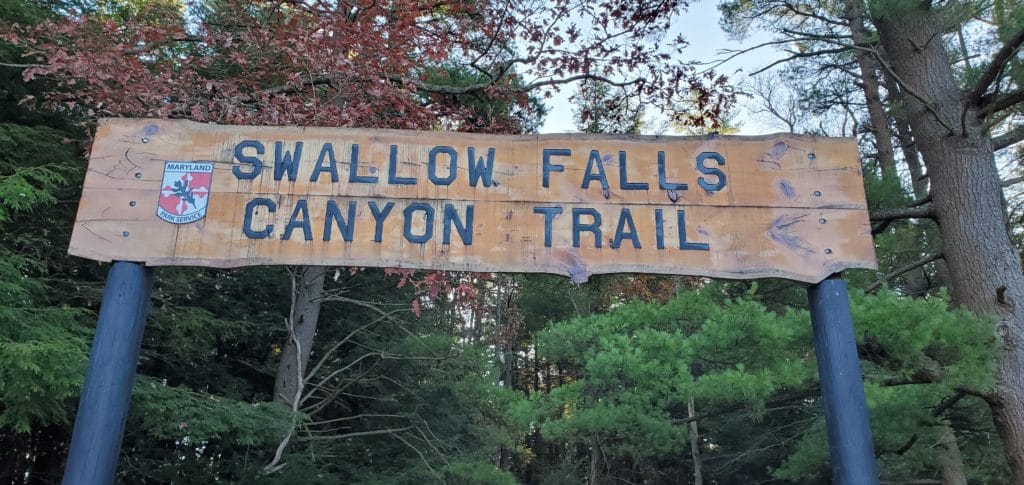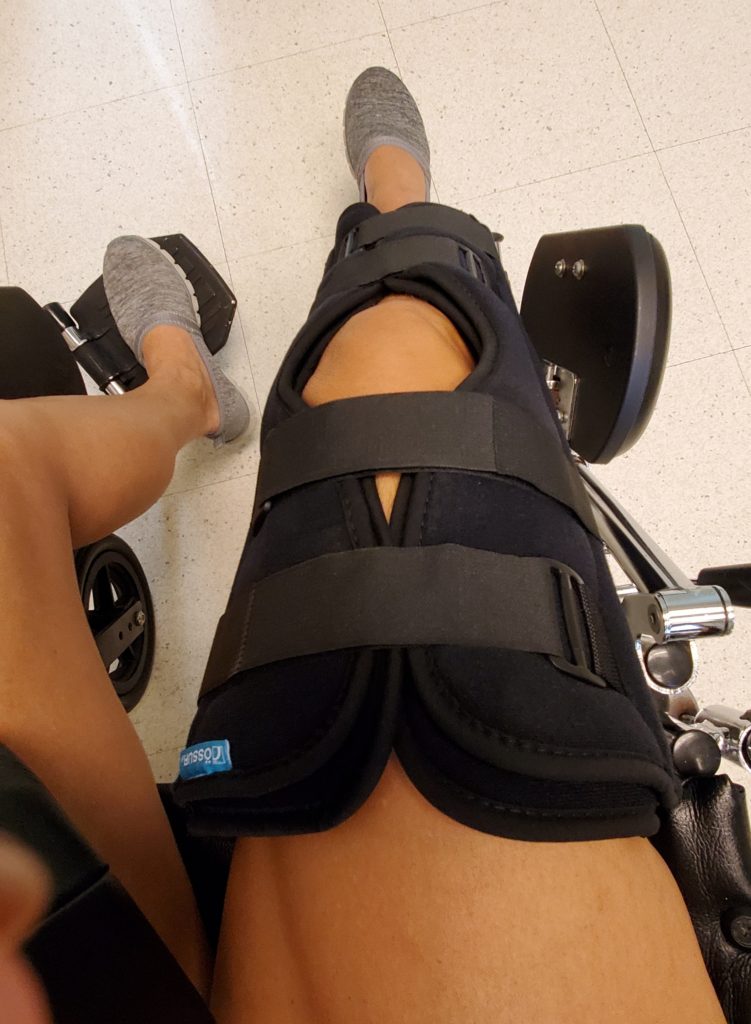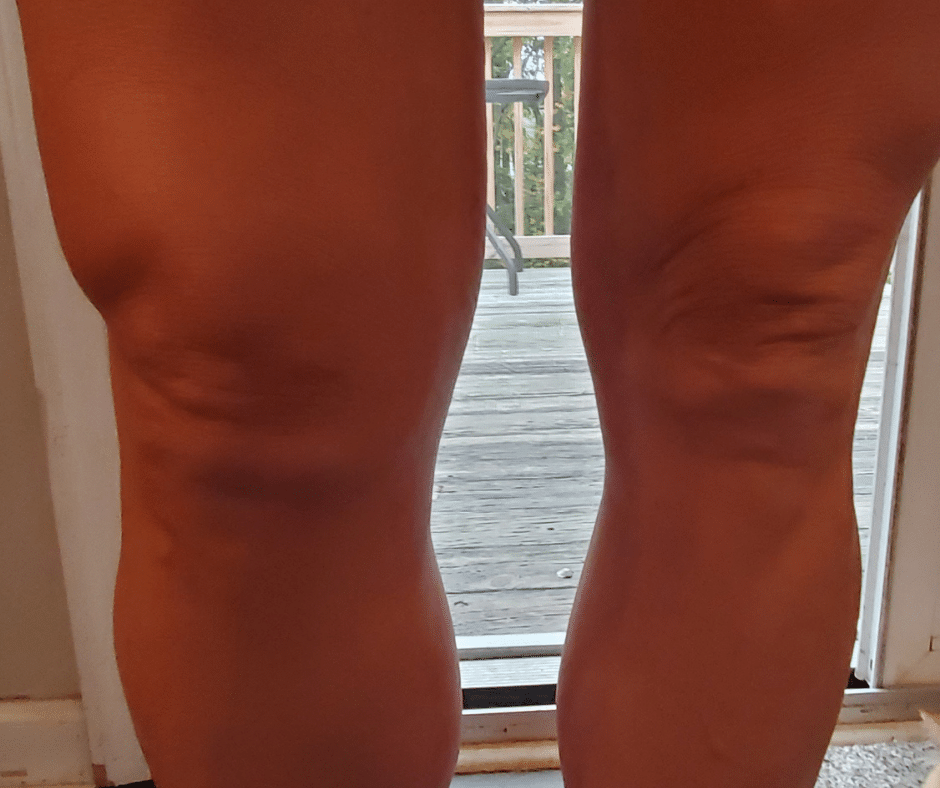This isn’t one of my regular blog posts where I talk about some topics specific to health and wellness, exercise and fitness, eating better, or a healthy mind and mind-set.
This is a true life story – it’s my own story. And it’s happening right now.
I want to tell you this story since you or someone you know might be going through or have gone through the same thing at this age. I also want to continue to share this story with you, mostly because it’s cathartic, but also because you might read something of value in here for yourself or someone you love. This is the story of my reconstructive knee surgery.
Hiking Adventure Gone Bad

It was just a few weeks ago when I was enjoying one of my favorite fall pastime activities: hiking. My boyfriend and I, along with Havoc, his German Shepherd pup, took a short vacation into western Maryland, hiking the state parks around Deep Creek Lake. At least that was the goal.
On the 3rd day of the vacation, I badly twisted my knee while hiking through Swallow Falls State Park. It was by far the easiest of all the hiking trails we’d been on, but I went and did something foolish. I hiked off-trail and tested my bravery by jumping off a rock down a distance of less than 2 ½ feet. My left foot landed solid, but my right did not. My knee twisted hard left, made all kinds of nauseating popping, snapping, popping noises, and down I went, howling in pain.
Having taken an alternate (and smarter path), my boyfriend was alerted to my whereabouts by my howling. He found me right away, got me up, and scouted a path forward, over rocks and leaves, under and over downed trees, and guided me out of the woods. My right leg shook during the slow trip out, and if I didn’t place my foot just right, my knee continued to buckle and bend at obscene angles.
By the time we got on a path and back to the truck, my knee was noticeably swollen. I couldn’t put weight on my leg, nor could I fully straighten or bend it. My left leg was getting tired of doing all the work. All of the unevenness made my whole body hurt.
We got back to the cabin, where I did all the things I was supposed to do. I iced the knee, elevated it, used as much compression as possible with what I had available, and rested.
After several rounds of icing the knee, the swelling hadn’t gone down.
In the winter of 2018, I’d twisted the same knee, trying to shovel my car out of a snowdrift. My leg went one way, my knee another. There was no snapping and popping noises at that time. It didn’t swell up, and while it stiffened after I sat or stood for a bit, I could still walk normally.
This time was different. Worry set in.
How Bad Is It?

I started searching, “how badly did I injure my knee?” on the internet. I had a pretty good idea of the extent of the injury in the back of my mind, but I needed Dr. Google to confirm. Multiple sources cited some kind of ligament tear.
As soon as we got home, I went to urgent care. The most they could do was give me an x-ray, which showed that nothing was broken. That was good news, but the fact that I still couldn’t bend or straighten my very swollen knee was concerning. I was more excited to get a pair of crutches so that I could move around more quickly. They also gave me a knee brace that went halfway up my thigh. It seemed overkill, so I only wore it once.
Not My First Rodeo
This isn’t my first ortho adventure.
In 2011, I had femeroacetabular osteoplasty surgery on my right hip, which is basically a fancy term for hip impingement surgery. Unlike many who have this surgery, mine wasn’t the result of an injury. I just happened to grow funny in the womb, and as a result, my leg did not have its full range of motion in the hip socket. It only became problematic in my 40s when my hip started popping, snapping, and catching, and I had constant low back discomfort.
It was a chance conversation with a co-worker that led me to a diagnosis of hip impingement. I’d been to a chiropractor who diagnosed bursitis in my hip and my family doctor who diagnosed spinal stenosis in my low back. It wasn’t either of those, and the discomfort continued for 8 years. At lunch once day, this co-worker casually mentioned that he’d be spending a few days a Thomas Jefferson University Hospital in Philadelphia for hip surgery on both hips. As he described his symptoms, which resulted from numerous hockey injuries, it all made sense.
Finding the Right Doctor
I made the first appointment I could with Dr. Javad Parvisi at the internationally recognized Rothman Institute, and after an x-ray and follow on MRI, I had my diagnosis. Hip impingement and torn labrum. My mother accompanied me on that trip and remarked quizzically, “The pediatrician did say something was off with your hips at your 6- month checkup, but it never stopped you from doing anything, so I never bothered.” It also made sense now why I could never bring my right leg as close to my chest as I could my left on a leg press.
The surgery that followed required resurfacing of the hip bone to remove the calcium deposits that had shredded my labrum, stitching of what remained of my labrum, and shaving part of my pelvis to accommodate the ball of my hip in the hip socket.
I stayed in the hospital overnight and was sent home with crutches and butterfly tape over the incisions. The recovery protocol required me to stay off my feet for two weeks and gradually work up to weight-bearing after eight. In fact, I didn’t begin physical therapy until 9 weeks after surgery.
I walked into physical therapy still on crutches on October 30. I told the therapist I planned to be hiking by Christmas because I was traveling to New Mexico to see my parents, and that’s what I do. She laughed and said, “We’ll see, but I’m not sure of that.”
A few days before Christmas in 2011, I was back out on the trails.
In 2015, I became symptomatic in my hip again. Sure enough, part of my labrum tore again. This time, the recovery protocols had evolved and were completely different. I started PT the day after surgery. I was fully weight-bearing in two weeks. Eight weeks to the day, I was back on a Pilates Reformer like I hadn’t missed a beat.
Getting the Right Care – Again
Knowing that I needed the diagnosis and care of an orthopedist for this knee injury, I didn’t think twice and once again called the Rothman Orthopaedic Institute. It would be nearly two weeks after the injury before I could be seen. It wasn’t ideal, but I knew I’d get the best possible care.
I was scheduled with Dr. John Salvo, orthopedic surgery and sports medicine, specializing in sports injuries, knee ligament (ACL & PCL) reconstructions, and meniscus tears. And it doesn’t hurt that he’s a team physician for the Philadelphia Eagles and the Philadelphia Flyers and a consultant for the Philadelphia Phillies. I’ll never be an athlete, but I know I’m in the care of someone who understands how much it means to be able to get back to my regular fitness activities.
While I waited that two weeks, my knee improved dramatically. The swelling subsided substantially, I no longer needed crutches, I could walk almost normal, I could bear full weight on the leg and go up and down the stairs almost normally. And I wasn’t really in any pain. I couldn’t really bend and straighten it all the way, and it woke me up at night, but I figured that was because I kept trying to bend it while I was sleeping. “Hmmm,” I thought, “Maybe it’s just a bad sprain?” Based on that, I was eager to see if Dr. Salvo would confirm my new self-diagnosis and let me know when I could get back to doing squats and deadlifts.
The Diagnosis
On the day of my appointment, Dr. Salvo greeted me with a crisp air of professionalism. He asked me a few questions, felt my knee, moved my leg around for a little bit, and said, “Well, you tore your ACL. And maybe your meniscus. We’ll get you downstairs for an MRI right away. But that’s what it looks like.”
“Sonofab….” I said, letting the rest trail off. I have the mouth of a sailor, but he didn’t need to know that.
I laughed and said, “Well, I kind of suspected that but was hoping for otherwise, ‘cos, you know I googled the crap out of this.” He sort of smiled and shook his head and said, “Yeah, Dr. Google is a friend to all of us.”
I had my MRI that afternoon and was scheduled for a follow-up consult a few days later. At that follow-up appointment, Dr. Salvo came into the patient room, holding a plastic replica of a knee and its associated ligaments. The good news was, both the lateral collateral ligament and the medial collateral ligament were fine. But sure enough, the ACL was torn and would need surgical repair, or more ominously stated, reconstructive surgery. “Given what you described, it makes sense that this is what occurred.”
As he explained, which I did not know, your ACL is the only ligament in the knee that does not repair itself. It needed intervention. Patients under 30 years of age are candidates to have replacement ligament harvested from their own bodies. At 53, I require a donor or cadaver ligament to make the repair.
My meniscus was also torn. To what degree he wasn’t sure, but it too would need to be repaired. Whether it could just be trimmed or needed stitching wouldn’t be known until he was in there. The latter is a worst-case scenario and has implications for a longer recuperative period.
Reality Sets In
Then he began to talk about the recovery period. As I listened, I felt myself shrink a little bit inside.
Four months in a leg brace, except for when I shower.
Physical therapy twice weekly for four months.
No yoga for eight to nine months.
Throughout the entire ordeal with my hip, all I wanted to do was get back to hiking. It’s what drove me and kept me determined to do whatever I had to so that could happen. With this knee injury, getting back to walking with my normal gait is the only goal Dr. Salvo is looking at. Everything else will have to wait.
I’ll admit, over the last couple of days, I’ve been a little scared – about a lot of things: the pain I know come after the recovery, having to rely on someone to help me do the basics, how long the recovery will take, and losing all the gains I made in the gym and yoga. And scared about losing my independence.
Mostly it’s about fear of losing control. There’s so much of this I don’t have control over. My body has to do what it needs to do in the time it needs to do it. None of that will coincide with my timeline. I’m not going to be able to get back on a leg press machine, squat rack, or do deadlifts any time soon. I won’t be taking my 2.5 mile walk every day like I did until the spring, at least.
Putting on My Game Face
It would be so easy to let all of this fester in my brain and take over my every thought, plunging me into self-pity and depression. I won’t do that. It gets me nothing and nowhere, and it’s not helpful in the least. It’s trite and cliché to say, but “It is what it is.”
Instead, I’ll take control of what I can, and look at what I’ve already done that will do nothing but help hasten my recovery.
Except for a week here or there, I’ve been exercising regularly – meaning 5 days a week – for nearly three years. My weight is under control, and I’m at least 20 pounds lighter than when I had both hip surgeries. Yes, I am 53, but I am a strong, healthy, flexible fifty-three.
The work I’ve put into building my health and wellness over the last several years I’ve done for exactly this reason – so that when confronted with a physical issue or ailment, I’ve exponentially improved my chances for a full recovery.
I’ve reflected on those last two hip surgeries, and although reconstructive knee surgery will be more painful and have a longer recovery time, there’s nothing that makes me think that I won’t have the same successful outcome. Come May 2021, I’m looking forward to that 2.5-mile walk around the neighborhood. Even better, if the coronavirus is under control and the world begins to return to normal, I’ll plan for a hike in New Mexico. Mark my words.
Setting Myself Up for Success
I haven’t been to the gym since I injured my knee and won’t be going back any time soon. But starting tomorrow, I’ll be back in my little home gym in my living room, going through my new pre-op, surgical workout. I won’t be doing squats or lunges, but I will be doing safe quad-strengthening and upper body exercises. I’ll be doing gentle stretching and core conditioning.
Most importantly, I’ll not let fear swallow me whole. I CAN do this. I WILL do this.
In FEMA, they count the hours before landfall of a hurricane as “L -96”, etc. For this, I’ll be counting that in days before surgery.
Today is S -15. I’m ready.

